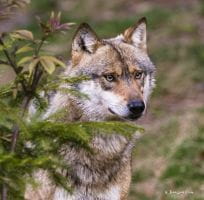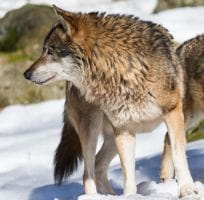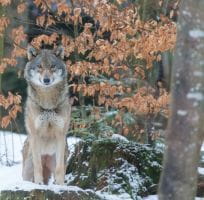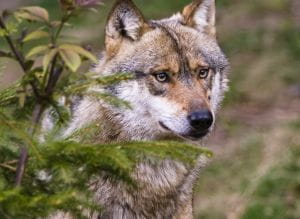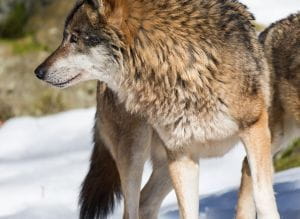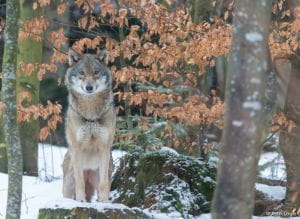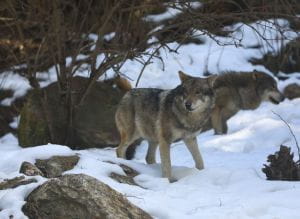The WOLF (Canis lupus)
There are now 37 species of canid, spread across the globe, of which the best-known representatives are: jackals, wolves, foxes, domestic dogs, coyotes, dholes, wild dogs, …
The size of the Grey Wolf varies according to its geography, according to Bergmann’s rule, which correlates the temperature of the environment to the volume/body surface ratio. In other words, the colder the environment, the bigger the wolf. Siberian and Scandinavian wolves, although of the same species as Mediterranean wolves, are bigger and heavier. While in France, the average height and weight of wolves is 70 to 80 cm at the withers for 25 to 35 kilos (depending on sex and environment), in Russia they are around 80 cm at the withers for 50 kilos.
The Grey Wolf’s appearance shows great variability depending on the region of origin. Many subspecies have been described on the basis of a few individuals, without taking into account the natural phenotypic variability of the species. Today, the debate still rages between advocates of a few species with many phenotypes and those who create subspecies in all regions of the world.
To simplify this chaotic phylogeny, we’ll be talking here about geographical distributions rather than known subspecies. Thus, we can distinguish:
- North American wolves (Canis lupus spp)*,
- Eurasian wolves (Canis lupus spp)*,
- Oriental wolves (Canis lupus spp)*,
- The European gray wolf (Canis lupus lupus),
- The Italian wolf (Canis lupus italicus),
- The Iberian wolf (Canis lupus signatus).
*the Latin name ending in spp is a grouping of several known subspecies.
Originally very present in northern Eurasia (southern limit: Himalayas, Middle East, Caucasus, Black Sea), the distribution of the European gray wolf (Canis lupus lupus) was greatly reduced in the 19th and 20th centuries. In recent years, the species has made a timid comeback in Western European countries and east of China.
The Iberian wolf (Canis lupus lupus) is one of the world’s most endangered species.
The Iberian wolf (Canis lupus signatus), meanwhile, is growing rapidly, but for some unknown reason its range does not extend further than the Pyrenees.
The Italian wolf (Canis lupus signatus), meanwhile, is growing rapidly.
The Italian wolf (Canis lupus italicus) is found in southeastern France and throughout Italy, and increasingly shares its territory with the European gray wolf.
.
Beware: all these subspecies are perfectly fertile with each other. In some cases, several wolf subspecies can even be found in the same pack!
Did you know?
In addition to all these subspecies, in recent years we’ve had to add to them, all over Europe, the hybrids resulting from an increasingly marked cohabitation with stray domestic dogs!
A little French pride: in 2017, the ONCFS published a genetic study establishing that wolf hybridization was a very limited phenomenon in France.
An ancestral cohabitation with man
Hunter-gatherers have long shared the same territories as wolves. This ancient cohabitation is attested to by wolf bones found on sites occupied by man: at Tautavel or even in the Lazaret cave in Nice.
The wolf was the first animal domesticated by nomadic Arctic peoples, over 12,000 years ago. This encounter testifies to a mutual fascination.
It’s difficult to understand why.
It’s hard to imagine that humans at the time could have seen the wolf as a threat to their survival, as they took in orphaned cubs and entrusted them to the women of the clan! And so the “first dogs” appeared.
It’s only fairly recently that rural societies, in the service of political and religious powers, have engaged in one of the most active and effective persecutions that man has inflicted on a living being. Between 1797 and 1798, 12,000 to 14,000 wolves were killed in France, at a time when guns were rare. By 1850, their population was estimated at between 3,000 and 7,000 adults.
A law was passed in 1882 to exterminate the wolf. It disappeared from France in 1939.
However, man has never succeeded in totally eliminating it in Europe. Its potential for survival and adaptation defends it better than any action on its behalf. And after an absence of more than 50 years, the wolf is back in the Alps.
The big comeback
Arrived in 1992 in Vésubie (Alpes-Maritimes), the wolf, which came from Italy, has now settled in just about everywhere in the Alps. With “avant-gardes” in the Massif Central, the Pyrenees, and the Vosges.
A very discreet animal, for a long time invisible, the wolf has tended to show itself in recent years, most often on ridges and sometimes right up to the outskirts of villages. Today, there are some twenty breeding packs, including 14 in the PACA region. So it’s hardly surprising that the Réserve des Monts D’Azur is at the heart of the territory of the Cheiron pack, one of the five packs in the Alpes-Maritimes department. After Mont Ventoux and Montagne de Lure, colonization continues in the Sainte-Baume massif (Var and Bouches du Rhône). Dispersal is, in fact, the key to the pack’s survival.
The Cheiron pack marks its passage through the Monts d’Azur Biological Reserve by the presence of killed and “cleaned” prey (mostly deer and sometimes wild boar). Tracks on a path, tracks in the snow and sometimes droppings confirm its passage. The howling of the pack, accompanied by young of the year, is frequently heard around the Reserve.
The return of this large carnivore means increased surveillance of the herds, but also the presence of dogs and protective nets. Although these measures are sometimes resented by shepherds, they are nonetheless effective. They have proved their worth in Italy and Spain, where cohabitation is much more peaceful than in France.
Pack life
The social life of the wolf is organized around the dominant couple, known as the “alpha couple”. The only ones to reproduce, it is they who organize the pack’s hierarchy and activities, accompanied by a mature adult, male or female.
All the wolves in a pack are united by family ties. Sometimes, isolated individuals navigate between several groups, without really belonging to them. The dominance of the alpha couple is constantly challenged by the young adults (males and females). The pack is therefore in constant evolution, with the occasional adoption of lone wolves from outside the pack. Logically, the bigger the pack, the more frequent the fights, and vice versa.
Pack organization is directly linked to the biotic and abiotic conditions of the territory. The larger and more resource-rich the territory, the greater the number of individuals in the pack. European packs have an average of 4 to 6 members over 300 km²; North American packs have as many as 15 individuals over almost 4,000 km²!
In the Alps, the pack can be as large as the territory itself.
In the Alps, the pack generally consists of two to three adults, with young of the year. The “historic” packs of the Mercantour range from five to seven individuals, exceptionally ten. Their size varies with the number of prey available.
The life of the pack is focused entirely on caring for and feeding the young, hunting and defending the home range. The home range covers 200 to 300 km². Calving takes place from late March to mid-May. Weaned at around 8 to 10 weeks, the cubs leave the den for the “rendezvous” site. Still too small to follow the adults, this is where they await the return of the hunt, either alone or under adult supervision. The rendezvous site is abandoned in early autumn.
The dominant pair manages the hunt and the pack’s movements, while the young take part in feeding and raising the cubs. To this end, they have great communication skills: chemical, auditory or visual, which help to strengthen pack solidarity.
The wolf is the most important member of the pack.
The wolf, opportunistic carnivore
An opportunistic carnivore, it adjusts its menu to the territory it occupies. Large wild ungulates are his preference: deer, chamois, roe deer and wild boar. He also preys on smaller prey, such as hares, rabbits and small rodents, during the summer months, and on carrion during harsh winters.
This is an opportunistic carnivore.
The average number of large ungulates killed by a pack in a year is estimated at between 50 and 70. For the record, the wild ungulate population in France has increased tenfold in 30 years. More than 40,000 stags and hinds and 500,000 roe deer are hunted every year.
In all cases, the wolf goes for the easiest, avoiding excessive risk-taking by quickly abandoning pursuit of prey deemed too vigorous. Hence its taste, in summer, for poorly protected herds.
A dynamic dispersal
At around 2 years of age, having reached sexual maturity, young adults have 2 choices: either they defy their parents to take control of the pack, or they leave the parental territory.
They will then travel dozens of kilometers to find an available conspecific and territory and found a new pack. This explains why, in the space of twenty years, the wolf has become established in most of the Alpine departments, in Lozère and as far as the eastern Pyrenees.
The wolf is a protected species.
Protected by the Bern Convention and the Habitats Directive, the wolf has nevertheless just been removed from France’s list of threatened species. It is expanding and gaining ground, benefiting from the increase in wild ungulate populations, the spread of forest, and the retreat of the rural world. But is its future secure?
cohabitating in peace…
Get to know the wolf better to protect yourself and live together in peace.
Large predators play a key role in the balance of ecosystems. They are the surest guarantors of the good health of herds of wild herbivores, by eliminating sick animals early on. They also help to protect overgrazed natural areas by dispersing their prey.
Will we be able to share part of our rural territories with them, or will we continue to treat them as pests? The question remains unanswered in France, whereas our German, Italian and Spanish neighbors have demonstrated that it is possible to design a mutually beneficial cohabitation, with environmental benefits and tourism spin-offs more than compensating for agricultural losses. In the USA, tourism authorities estimate the annual revenue generated by the presence of wolves in Yellowstone Park at $35 million!
…WITH A KEY SPECIES
A super-predator, the wolf plays an essential role in ecosystems the world over. Well-adapted wolf populations help to prevent overgrazing by herbivores and promote plant regeneration.
Wolves are a keystone of ecosystems worldwide.
Wolves select for weak, sick or aged prey, helping to keep herbivore populations healthy. This selective predation has a number of knock-on effects that are beneficial to ecosystems:
Wolves are the most effective predators of herbivores.
- Wolves limit the overpopulation of herbivores,
- They thus reduce the overconsumption of vegetation by these same herbivores,
- The naturally degrading carcasses enable a wide variety of necrophagous animals to settle in and energize the entire ecosystem,
- The development of vegetation increases the diversity of habitats for small fauna,
- More insects, rodents and amphibians increase ecosystem interactions.
A final clarification: the wolf’s diet is only weakly correlated with livestock farming and human activities! A 2012 study, by the Office Française de la Biodiversité, carried out on 9 packs in the Alps showed that the wolf’s diet was composed of:
- 76% wild ungulates (mainly roe deer and chamois),
- 16% domestic animals (mainly sheep)
- 8% other (rodents, birds, fruit, carrion, …).
